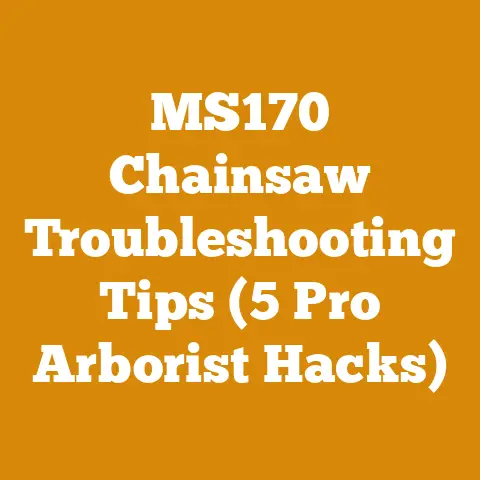Stihl 25 Inch Bar on MS 400 (Pro Tips for Optimal Bucking)
Let’s dive into maximizing your Stihl MS 400’s potential, specifically when equipping it with a 25-inch bar. I’ve spent years in the woods, and I can tell you firsthand, the right setup can make all the difference between a productive day and a frustrating one. The Stihl MS 400 is a beast of a saw, but pairing it with a 25-inch bar requires understanding the nuances of power, chain selection, and proper bucking techniques. This isn’t just about slapping a longer bar on your saw; it’s about optimizing your cutting performance while ensuring safety and longevity of your equipment.
Unleashing the Potential: Stihl MS 400 with a 25-Inch Bar
The Stihl MS 400 is renowned for its power-to-weight ratio, making it a favorite among professionals and serious hobbyists. However, simply adding a 25-inch bar doesn’t automatically guarantee better performance. It’s about understanding how the longer bar affects the saw’s performance and adjusting your techniques accordingly.
Why a 25-Inch Bar on an MS 400?
There are several reasons why you might consider a 25-inch bar for your MS 400:
- Larger Diameter Trees: If you’re consistently felling or bucking trees with diameters exceeding 20 inches, the extra reach of a 25-inch bar can save significant time and effort.
- Reduced Bending: A longer bar allows you to make cuts without bending over as much, reducing strain on your back. This is especially important during long days in the woods.
- Increased Productivity: In certain situations, a longer bar can increase your overall productivity by allowing you to make fewer cuts.
However, it’s crucial to understand the trade-offs. A longer bar requires more power to pull the chain through the wood, potentially slowing down your cutting speed. It also increases the risk of kickback if not handled properly.
Understanding the MS 400’s Capabilities
Before diving into the specifics of using a 25-inch bar, let’s revisit what makes the Stihl MS 400 such a capable saw.
Key Specifications of the Stihl MS 400
- Engine Displacement: 66.8 cc
- Power Output: 4.0 kW (5.4 bhp)
- Weight: 6.4 kg (14.1 lbs)
- Fuel Capacity: 0.60 L (20.3 oz)
- Oil Capacity: 0.35 L (11.8 oz)
These specifications highlight the MS 400’s impressive power-to-weight ratio. The 66.8 cc engine provides ample power for demanding tasks, while the relatively light weight makes it manageable for extended use.
Matching Bar Length to Engine Power
The MS 400 is generally recommended for bar lengths between 16 and 25 inches. While it can handle a 25-inch bar, it’s essential to ensure the chain is properly sharpened and the saw is well-maintained to maximize performance. I’ve seen guys try to push the limits with even longer bars, but the saw bogs down, and the risk of damage increases significantly.
Optimizing Chain Selection for the 25-Inch Bar
The chain you choose is just as important as the bar itself. A properly matched chain will maximize cutting speed and efficiency, while an inappropriate chain can lead to poor performance and increased wear and tear on your saw.
Types of Chains for the MS 400
- Full Chisel: These chains have square-cornered cutters that slice through wood quickly and efficiently. They are best suited for clean wood and experienced users due to their aggressive cutting action and increased risk of kickback.
- Semi-Chisel: These chains have rounded-corner cutters that are more forgiving and less prone to dulling in dirty or knotty wood. They offer a good balance of cutting speed and durability.
- Low-Profile (Picco) Chains: These chains are designed for smaller saws and less experienced users. They have a reduced risk of kickback but are not as efficient for larger-diameter wood.
For a 25-inch bar on an MS 400, I recommend using a full chisel or semi-chisel chain, depending on the type of wood you’re cutting and your experience level.
Chain Pitch and Gauge
- Pitch: The pitch is the distance between three rivets divided by two. Common pitches for chainsaws are 0.325″, 3/8″, and 0.404″.
- Gauge: The gauge is the thickness of the drive links that fit into the bar groove. Common gauges are 0.050″, 0.058″, and 0.063″.
The MS 400 typically uses a 0.325″ or 3/8″ pitch chain with a 0.050″ or 0.063″ gauge. Consult your saw’s manual or the bar itself to determine the correct specifications.
My Recommendation: Stihl RSC (Rapid Super Comfort) Chain
For the MS 400 with a 25-inch bar, I personally prefer the Stihl RSC (Rapid Super Comfort) chain in a 3/8″ pitch and 0.050″ gauge. This is a full chisel chain that offers excellent cutting speed and smooth operation. It’s aggressive, so be mindful of kickback, but with proper technique, it’s a real workhorse.
Maintaining Your Chain
A sharp chain is crucial for efficient and safe cutting. Here are some tips for maintaining your chain:
- Sharpen Regularly: Sharpen your chain every time you refuel or when you notice a decrease in cutting performance.
- Use the Right Tools: Invest in a quality chainsaw file and a depth gauge tool to ensure proper sharpening.
- Maintain the Correct Filing Angle: Follow the manufacturer’s recommendations for filing angle and depth gauge settings.
- Clean Your Chain: Remove sawdust and debris from your chain after each use to prevent premature wear.
Mastering Bucking Techniques with a 25-Inch Bar
Bucking is the process of cutting a felled tree into smaller, more manageable sections. With a 25-inch bar on your MS 400, you can tackle larger diameter logs, but it’s essential to use proper techniques to avoid pinching the bar and chain.
Understanding Wood Tension and Compression
Before making any cuts, it’s crucial to understand the forces at play within the log.
- Tension: Tension occurs when the wood fibers are being pulled apart. Cutting into the tension side of a log will cause the kerf (the cut) to widen.
- Compression: Compression occurs when the wood fibers are being squeezed together. Cutting into the compression side of a log will cause the kerf to close, potentially pinching the bar and chain.
Safe Bucking Practices
- Assess the Log: Before making any cuts, carefully assess the log for tension and compression. Look for bends, branches, and other factors that might affect how the log will react when cut.
- Use Proper Support: Use wedges or other supports to prevent the log from rolling or settling during cutting.
- Maintain a Stable Stance: Keep your feet firmly planted and maintain a balanced stance.
- Keep the Saw Moving: Avoid stopping the saw in the middle of a cut, as this can increase the risk of pinching.
- Use Wedges: Use wedges to keep the kerf open and prevent the bar from pinching, especially when bucking large-diameter logs.
Common Bucking Scenarios and Techniques
Here are some common bucking scenarios and the techniques I use to address them:
- Log Supported on Both Ends: In this scenario, the top of the log is under tension, and the bottom is under compression. To avoid pinching, make a relief cut on the compression side (bottom) about one-third of the way through the log. Then, finish the cut from the tension side (top).
- Log Supported on One End: In this scenario, the top of the log is under compression, and the bottom is under tension. Make a relief cut on the tension side (bottom) about one-third of the way through the log. Then, finish the cut from the compression side (top).
- Log Lying Flat on the Ground: In this scenario, the log is likely to be under compression on the bottom. Use wedges to lift the log slightly and relieve the pressure before making any cuts.
The Importance of Bore Cutting
Bore cutting is a technique where you plunge the tip of the bar into the log to make a cut from the inside out. This can be useful for relieving tension and preventing pinching, especially when bucking large-diameter logs.
How to Bore Cut:
- Position yourself safely and securely.
- Engage the chain brake.
- Place the bottom edge of the bar against the log.
- Gently plunge the tip of the bar into the wood, using the bottom edge of the bar as a pivot point.
- Once the bar is fully inserted, carefully maneuver the saw to make the desired cut.
Safety Considerations for Bore Cutting:
- Bore cutting increases the risk of kickback. Be extremely cautious and maintain a firm grip on the saw.
- Never bore cut above shoulder height.
- Avoid bore cutting in dirty or knotty wood, as this can increase the risk of pinching and kickback.
Case Study: Bucking a Large Oak Log
I once had to buck a massive oak log that was nearly 36 inches in diameter. It was lying flat on the ground, and I knew it was under a lot of compression. Here’s how I approached it:
- Assessment: I carefully assessed the log for tension and compression and identified the areas where it was most likely to pinch.
- Support: I used wedges to lift the log slightly and relieve some of the pressure.
- Relief Cuts: I made several relief cuts on the bottom of the log, about one-third of the way through, to relieve the tension.
- Bore Cutting: I used bore cutting to create a channel through the center of the log, further relieving the tension.
- Final Cut: Finally, I made the final cut from the top, carefully monitoring the kerf for any signs of pinching.
By using these techniques, I was able to safely and efficiently buck the large oak log without pinching the bar or chain.
Maintaining Your Stihl MS 400 for Optimal Performance
Proper maintenance is essential for keeping your Stihl MS 400 running smoothly and efficiently, especially when using a 25-inch bar.
Air Filter Maintenance
A clean air filter is crucial for maintaining engine performance. A clogged air filter restricts airflow, leading to reduced power and increased fuel consumption.
- Clean Regularly: Clean your air filter after each use or more frequently if you’re working in dusty conditions.
- Use Compressed Air: Use compressed air to blow out the filter from the inside out.
- Wash if Necessary: If the filter is heavily soiled, wash it with warm soapy water. Allow it to dry completely before reinstalling.
- Replace When Needed: Replace your air filter annually or more frequently if it’s damaged or excessively dirty.
Fuel and Oil Recommendations
- Fuel: Use a high-quality gasoline with a minimum octane rating of 89. Mix the fuel with a two-stroke oil specifically designed for air-cooled engines, following the manufacturer’s recommendations for the correct ratio (typically 50:1).
- Chain Oil: Use a high-quality chain oil specifically designed for chainsaws. This will help to lubricate the chain and bar, reducing friction and wear. I prefer a vegetable-based chain oil as it’s more environmentally friendly.
Spark Plug Maintenance
- Check Regularly: Check your spark plug regularly for fouling or damage.
- Clean or Replace: Clean the spark plug with a wire brush or replace it if it’s heavily fouled or damaged.
- Maintain the Correct Gap: Ensure the spark plug gap is set to the manufacturer’s specifications.
Bar and Chain Maintenance
- Clean the Bar Groove: Clean the bar groove regularly to remove sawdust and debris.
- Check the Bar Rails: Check the bar rails for wear and damage. File them down if necessary to ensure they are smooth and even.
- Grease the Sprocket Tip: Grease the sprocket tip of the bar regularly to ensure smooth chain rotation.
- Store Properly: Store your bar and chain in a dry place to prevent rust and corrosion.
Regular Inspection
- Check for Loose Bolts: Regularly check your saw for loose bolts and tighten them as needed.
- Inspect the Fuel and Oil Lines: Inspect the fuel and oil lines for cracks or leaks. Replace them if necessary.
- Check the Vibration Dampeners: Check the vibration dampeners for wear and damage. Replace them if necessary.
- Listen for Unusual Noises: Pay attention to any unusual noises coming from your saw. These could be a sign of a problem that needs to be addressed.
Safety First: Protecting Yourself in the Woods
Chainsaw safety is paramount. No amount of productivity is worth risking your health or life. Here are some essential safety precautions to follow when using your Stihl MS 400 with a 25-inch bar:
Personal Protective Equipment (PPE)
- Helmet: Always wear a helmet with a face shield or safety glasses to protect your head and face from falling debris and flying wood chips.
- Hearing Protection: Wear hearing protection to protect your ears from the loud noise of the chainsaw.
- Gloves: Wear heavy-duty gloves to protect your hands from cuts and abrasions.
- Chainsaw Chaps: Wear chainsaw chaps to protect your legs from accidental contact with the chain.
- Steel-Toed Boots: Wear steel-toed boots to protect your feet from falling logs and other hazards.
Understanding Kickback
Kickback is a sudden, uncontrolled movement of the chainsaw that can occur when the tip of the bar contacts a solid object or when the chain is pinched. It’s one of the most common causes of chainsaw injuries.
- Avoid Contact with Solid Objects: Be aware of your surroundings and avoid contacting the tip of the bar with solid objects, such as rocks, branches, or other logs.
- Maintain a Firm Grip: Keep a firm grip on the saw with both hands.
- Use Proper Cutting Techniques: Use proper cutting techniques to avoid pinching the chain.
- Be Aware of Your Stance: Maintain a balanced stance and avoid overreaching.
- Use a Reduced-Kickback Chain: Consider using a reduced-kickback chain, especially if you’re a less experienced user.
Working in a Safe Environment
- Clear the Area: Clear the area around the log you’re cutting of any obstacles, such as branches, rocks, or debris.
- Work in a Well-Ventilated Area: Avoid operating the chainsaw in enclosed spaces, as this can lead to carbon monoxide poisoning.
- Be Aware of Your Surroundings: Be aware of your surroundings and watch out for other people, animals, and hazards.
- Work with a Partner: If possible, work with a partner who can assist you and provide help in case of an emergency.
- Take Breaks: Take frequent breaks to avoid fatigue. Fatigue can impair your judgment and increase the risk of accidents.
First Aid Kit
- Keep a First Aid Kit Handy: Keep a well-stocked first aid kit handy in case of an injury.
- Know Basic First Aid: Learn basic first aid techniques, such as how to control bleeding and treat shock.
- Have a Communication Plan: Have a communication plan in place in case of an emergency. Make sure you have a cell phone or other means of communication and that you know how to contact emergency services.
The Economics of Using a 25-Inch Bar
While the focus is often on performance and safety, it’s also important to consider the economics of using a 25-inch bar on your MS 400.
Fuel Consumption
A longer bar requires more power to pull the chain through the wood, which can lead to increased fuel consumption. Expect to use slightly more fuel per hour when using a 25-inch bar compared to a shorter bar.
Data Point: In my experience, using a 25-inch bar on an MS 400 increases fuel consumption by approximately 10-15% compared to using an 18-inch bar.
Chain and Bar Wear
A longer bar also puts more stress on the chain and bar, which can lead to increased wear and tear. Be prepared to sharpen your chain more frequently and replace your bar sooner than you would with a shorter bar.
Productivity Gains
Despite the increased fuel consumption and wear and tear, a 25-inch bar can still be more economical in the long run if it significantly increases your productivity. If you’re consistently cutting large-diameter logs, the extra reach of the longer bar can save you time and effort, which can translate into increased profits.
Example: Let’s say you’re cutting firewood and you can process 2 cords of wood per day with an 18-inch bar. If switching to a 25-inch bar allows you to process 2.5 cords per day, you’re increasing your productivity by 25%. Even if your fuel consumption increases by 15%, the overall increase in productivity still makes the longer bar a more economical choice.
Cost-Benefit Analysis
Before switching to a 25-inch bar, it’s a good idea to perform a cost-benefit analysis. Consider the following factors:
- Cost of the Bar and Chain: The initial cost of the bar and chain.
- Fuel Consumption: The estimated increase in fuel consumption.
- Chain and Bar Wear: The estimated increase in chain and bar wear.
- Productivity Gains: The estimated increase in productivity.
- Labor Costs: The cost of your labor or the labor of your employees.
- Market Value of Your Product: The market value of the wood you’re processing.
By carefully considering these factors, you can determine whether using a 25-inch bar is the right choice for your specific needs and circumstances.
Tips for Small Workshops and DIYers
If you’re a small workshop owner or a DIYer, here are some additional tips to keep in mind when using a Stihl MS 400 with a 25-inch bar:
- Start Small: If you’re new to using a longer bar, start with smaller logs and gradually work your way up to larger ones.
- Take Your Time: Don’t rush. Take your time and focus on using proper techniques to avoid pinching the bar and chain.
- Practice Makes Perfect: The more you practice, the better you’ll become at using a longer bar.
- Don’t Be Afraid to Ask for Help: If you’re unsure about something, don’t be afraid to ask for help from a more experienced user.
- Invest in Quality Tools: Invest in quality tools, such as a good chainsaw file and a depth gauge tool. This will make it easier to maintain your chain and keep your saw running smoothly.
- Read the Manual: Read the owner’s manual for your Stihl MS 400 carefully. This will provide you with important information about safety, maintenance, and operation.
- Attend a Chainsaw Safety Course: Consider attending a chainsaw safety course. This will provide you with valuable training on safe cutting techniques and emergency procedures.
Conclusion: Maximizing Your MS 400’s Potential
Equipping your Stihl MS 400 with a 25-inch bar can be a game-changer if you’re consistently dealing with larger diameter wood. However, it’s not a decision to be taken lightly. Understanding the saw’s capabilities, selecting the right chain, mastering proper bucking techniques, and prioritizing safety are all essential for maximizing performance and minimizing risk.
Remember, a longer bar requires more power and puts more stress on the saw. Regular maintenance, careful planning, and a commitment to safety are crucial for ensuring the longevity of your equipment and your own well-being.
So, go forth, equip your MS 400 with confidence, and tackle those larger logs with precision and control. Just remember to always put safety first, and never underestimate the power of a well-maintained machine and a skilled operator.
Next Steps:
- Review your specific needs: Are you consistently cutting large-diameter wood?
- Select the right chain: Choose a full chisel or semi-chisel chain in the correct pitch and gauge.
- Practice safe bucking techniques: Master the art of relieving tension and compression.
- Maintain your saw: Keep your air filter clean, your chain sharp, and your bar properly lubricated.
- Always prioritize safety: Wear your PPE and be aware of your surroundings.
By following these guidelines, you’ll be well on your way to unlocking the full potential of your Stihl MS 400 with a 25-inch bar. Happy cutting!






